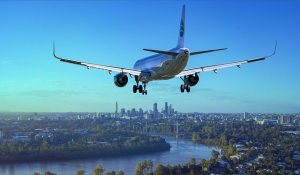
Stabilizers are an important part of most airplanes. Located on the tail assembly, they live up to their namesake by providing stability. Stabilizers are essentially aerodynamic surfaces that stabilize the airplanes with which they are used. Here are six facts about stabilizers and how they work.
#1) Vertical and Horizontal
There are vertical stabilizers. and there are horizontal stabilizers. Vertical stabilizers are characterized by their vertical, upright design. Horizontal stabilizers, on the other hand, feature a flat and horizontal design. They are both located on the tail assembly. In the center of the tail assembly is a vertical stabilizer. At the base of the tail assembly is a horizontal stabilizer.
#2) Maintains Longitudinal Balance
Stabilizers allow airplanes to maintain longitudinal balance. Also known as pitch stability, longitudinal balance is the stability of an airplane around the airplane’s lateral axis. With a vertical stabilizer and a horizontal stabilizer, airplanes can maintain longitudinal balance more easily.
#3) Fixed and Adjustable
While most stabilizers fall under the category of vertical or horizontal, they can further be broken down into fixed or adjustable. Fixed stabilizers consist of a fixed, non-adjustable aerodynamic dynamic on the tail assembly. Adjustable stabilizers, in comparison, can be adjusted. They typically feature hinges that allow them to rotate away from the tail assembly. Pilots can control adjustable stabilizers during flight.
#4) Requires Inspections and Maintenance
There are different types of stabilizers, but they all require regular inspections and maintenance. This is necessary to ensure their structural integrity and reliability. During an inspection, mechanical engineers will look for signs of wear, fatigue or structural damage. Problems such as these could compromise the stabilizer’s performance.
#5) Made of Strong and Lightweight Materials
Stabilizers are made of strong and lightweight materials. Aluminum alloy is a common material used in their construction. It consists of aluminum and one or more other metals or non-metallic elements. In addition to aluminum alloy, stabilizers are available in composite materials like carbon-reinforced polymers. Both aluminum alloy and composite materials are strong and lightweight. They also offer excellent protection against corrosion, making them ideal for use in stabilizers.
#6) Available in Different Configurations
Stabilizers are available in different configurations. Airplanes with a T-tail assembly use a vertical stabilizer positioned at the top, followed by a horizontal stabilizer positioned at the base of the assembly. Other airplanes, though, may use a different stabilizer configuration. Some of them have a horizontal stabilizer positioned at the lower part of the tail assembly.



